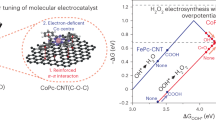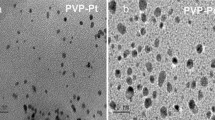Abstract
A mechanism for the bioreduction of H2PtCl6 and PtCl2 into platinum nanoparticles by a hydrogenase enzyme from Fusarium oxysporum is proposed. Octahedral H2PtCl6 is too large to fit into the active region of the enzyme and, under conditions optimum for nanoparticle formation (pH 9, 65°C), undergoes a two-electron reduction to PtCl2 on the molecular surface of the enzyme. This smaller molecule is transported through hydrophobic channels within the enzyme to the active region where, under conditions optimal for hydrogenase activity (pH 7.5, 38°C) it undergoes a second two-electron reduction to Pt(0). H2PtCl6 was unreactive at pH 7.5, 38°C; PtCl2 was unreactive at pH 9, 65°C.





Similar content being viewed by others
References
Ahmad A, Mukherjee P, Mandal D, Senapati S, Khan MI, Kumar R, Sastry M (2002) Enzyme mediated extracellular synthesis of CdS nanoparticles by the fungus Fusarium oxysporum. J Am Chem Soc 124:12108–12109
Ahmad A, Senepati S, Khan MI, Kumar R, Sastry M (2003) Extracellular biosynthesis of monodisperse gold nanoparticles by a novel extremophilic actinomycete, Thermomonospora sp. Langmuir 19:3550–3553
Ahmad A, Senepati S, Khan MI, Kumar R, Sastry M (2005) Extra-/Intracellular biosynthesis of gold nanoparticles by an alkalotolerant fungus, Tricothecium sp. J Biomed Nanotechnol 1:47–53
Bhainsa KC, D’Souza SF (2006) Extracellular biosynthesis of silver nanoparticles using the fungus Aspergillus fumigatus. Coll Surf B: Biointer 47:160–164
Elliot SJ, Leger C, Pershad HR, Hirst J, Heffron K, Ginet N, Blasco F, Rothery RA, Weiner JH, Armstrong FA (2002) Detection and interpretation of redox potential optima in the catalytic activity of enzymes. Biochim Biophys Acta 1555:54–59
Huang J, He C, Liu X, Xiao Y, Mya KY, Chai J (2004) Formation and characterisation of water soluble platinum nanoparticles using a unique approach based on the hydrosilylation reaction. Langmuir 20:5145–5148
Konishi Y, Ohno K, Saitoh N, Nomura T, Nagamine S, Hishida H, Takahashi Y, Uruga T (2007) Bioreductive deposition of platinum nanoparticles on the bacterium Shewanella algae. J Biotechnol 128:648–653
Lengke MF, Fleet ME, Southam G (2006) Synthesis of platinum nanoparticles by reaction of filamentous cyanobacteria with platinum (IV)-chloride complex. Langmuir 22:7318–7323
Liu Z, Ling XY, Su X, Lee JY (2004) Carbon supported Pt and PtRu nanoparticles as catalysts for a direct methanol fuel cell. J Phys Chem B 108:8234–8240
Mukherjee P, Senepati S, Mandal D, Ahmad A, Khan MI, Kumar R, Sastry M (2002) Extracellular synthesis of gold nanoparticles by the fungus, Fusarium oxysporum. Chem BioChem 5:461–463
Ngwenya N, Whiteley CG (2006) Recovery of rhodium (III) from solutions and industrial wastewaters by a sulphate reducing consortium. Biotechnol Progr 22:1604–1611
Rashamuse K, Whiteley CG (2007) Bioreduction of platinum (IV) from aqueous solution using sulphate reducing bacteria. Appl Microbiol Biotechnol 75:1429–1435
Riddin TL, Gericke M, Whiteley CG (2006) Analysis of the inter- and extracellular formation of platinum nanoparticles by Fusarium oxysporum f.sp. Lycopersici using response surface methodology. Nanotechnology 17:1–8
Xiao Y, Pavlov V, Levine S, Niazov T, Markovitch G, Willner I (2004) Catalytic growth of Au nanoparticles by NAD (P) H cofactors: optical sensors for NAD (P)+-dependent biocatalyzed transformations. Angew Chemie (Int Ed) 43:4519–4522
Yoshimura H (2006) Protein assisted nanoparticle synthesis. Coll Surf A: Physiochem Eng Asp 283:464–470
Zadvorny OA, Zorin NA, Gogotov IN, Gorlenko VM (2004) Properties of Stable hydrogenase from the purple sulphur bacterium Lamprobacter modestohalophilus. J Biochem (Moscow) 69:164–169
Acknowledgement
Financial assistance, from MINTEK (South Africa), for YG and TR is gratefully appreciated.
Author information
Authors and Affiliations
Corresponding author
Rights and permissions
About this article
Cite this article
Govender, Y., Riddin, T., Gericke, M. et al. Bioreduction of platinum salts into nanoparticles: a mechanistic perspective. Biotechnol Lett 31, 95–100 (2009). https://doi.org/10.1007/s10529-008-9825-z
Received:
Revised:
Accepted:
Published:
Issue Date:
DOI: https://doi.org/10.1007/s10529-008-9825-z




